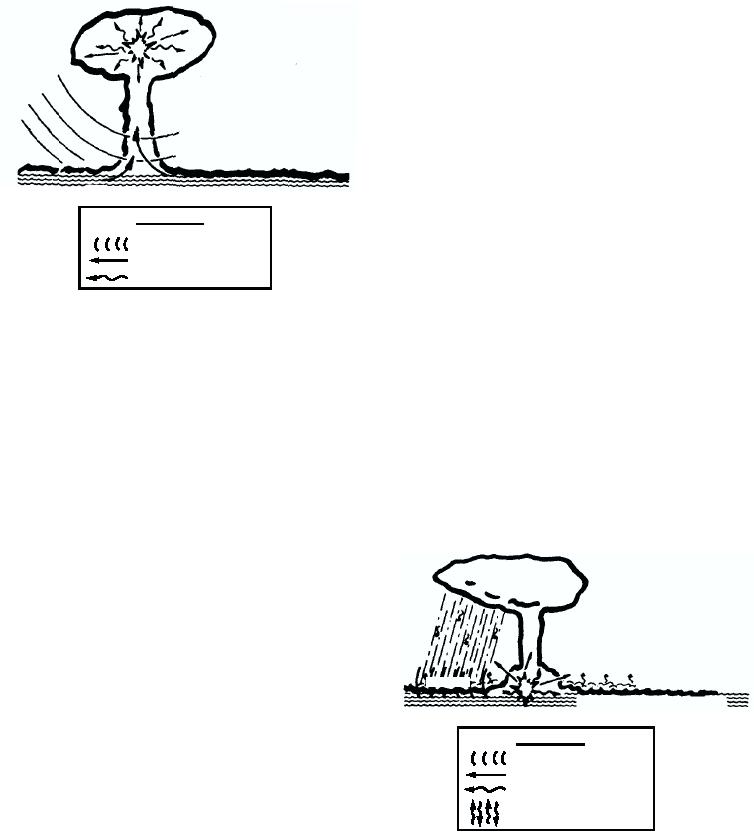
minutes to hours. The important effects of high-altitude
bursts cause damage to weapons systems or satellites
operating in the upper atmosphere or in space. There
will also be interference with electromagnetic waves
from communications or radar systems that pass
through or near the region of the burst.
SURFACE BURST
A surface burst (fig. 10-3) is a burst where the point
of detonation is on, or above, the surface of the earth
and the fireball touches the surface of the earth. The
EFFECTS
surface burst produces air blast, thermal radiation, and
AIR BLAST
electromagnetic pulse. It produces initial nuclear
THERMAL RADIATION
radiation around surface zero (SZ) and residual (transit
INITIAL RADIATION
and deposit) nuclear radiations around SZ and
DCf1002
downwind from SZ. Transit radiation is airborne
radioactive material from a base surge and/or fallout.
Figure 10-2. Airburst.
Deposit radiation is radioactive material from a base
surge and/or fallout that settles on exposed surfaces.
The energy released from a nuclear detonation
Surface bursts over water will also produce underwater
below an altitude of approximately 100,000 feet may
shock and surface water waves, but these effects will be
be divided into three broad categories. Approximately
of less importance except to submarines. Over land,
50 percent of the energy produces blast and shock,
earth shock will be produced but will not be an
about 35 percent produces thermal radiation, and about
important effect at any significant distance from the
15 percent produces nuclear radiation. Of the nuclear
point of detonation.
radiation, about 10 percent is referred to as "residual
nuclear radiation" and the other 5 percent as "initial
nuclear radiation." Initial radiation is delivered
simultaneously with the detonation and cannot be
avoided by maneuvering or evasive actions. The initial
radiation dose received will occur within 1 minute after
the explosion, and most of it will occur within a matter
of seconds. Residual radiation, on the other hand, may
be emitted over a long period of time, extending to days
BASE SURGE
and years. Therefore, maneuvering out of an area
FALL OUT
contaminated by residual radiation may be an effective
CONTAMINATED WATER
countermeasure.
EFFECTS
AIR BLAST
HIGH-ALTITUDE BURST
THERMAL RADIATION
INITIAL RADIATION
A high-altitude burst is an airburst where the point
TRANSIT RADIATION
of detonation is above 100,000 feet. The high-altitude
burst produces air blast, thermal radiation,
DCf1003
electromagnetic pulse, initial nuclear radiation, and
atmospheric ionization. At such high altitudes, the
Figure 10-3. Surface burst.
proportion of energy appearing as blast decreases
considerably, and at the same time, the proportion of
UNDERWATER BURST
radiation energy increases. Because of the low density
of the atmosphere above 100,000 feet, the range of the
An underwater burst (fig. 10-4) is a burst where
initial nuclear radiation increases. In contrast to
the point of detonation is below the surface of the
explosions below 50,000 feet, the attendant atmospheric
ionization from a burst above 100,000 feet will last from
water. An underwater burst produces underwater
10-3

